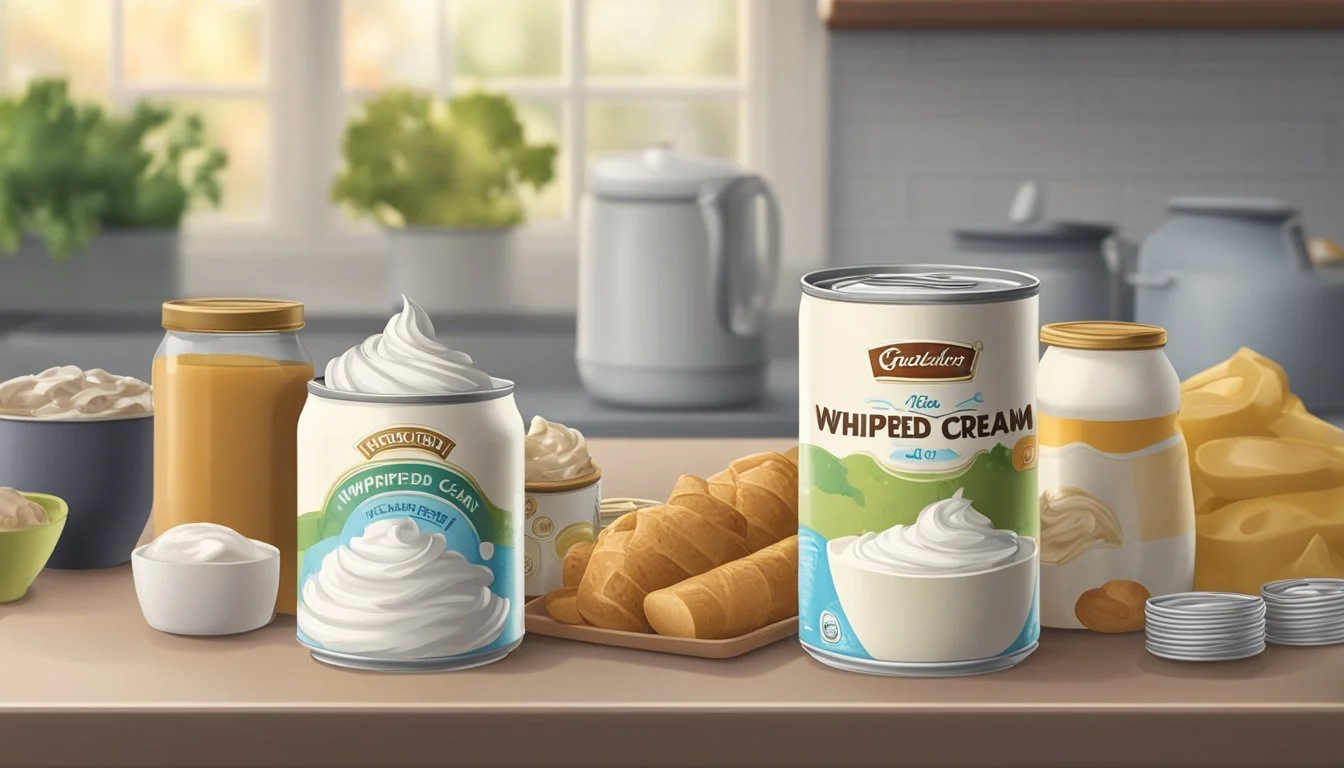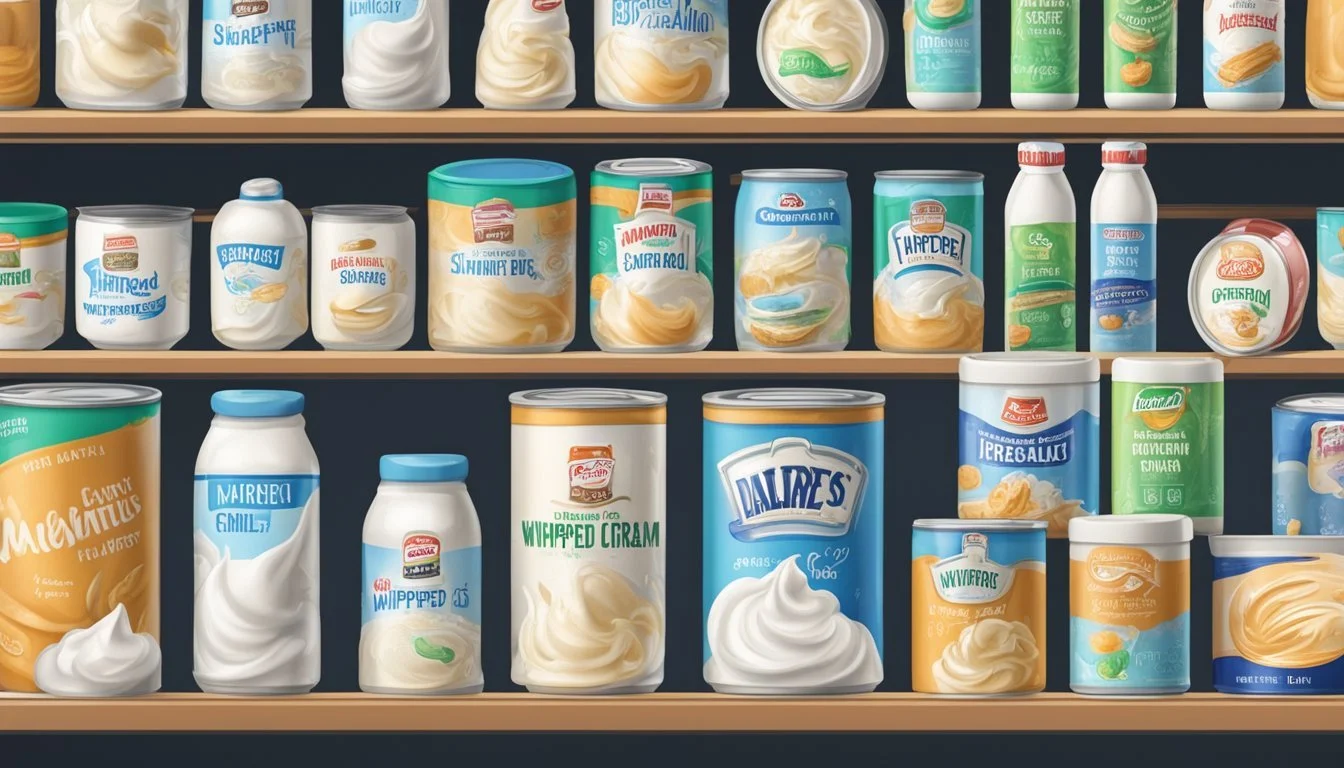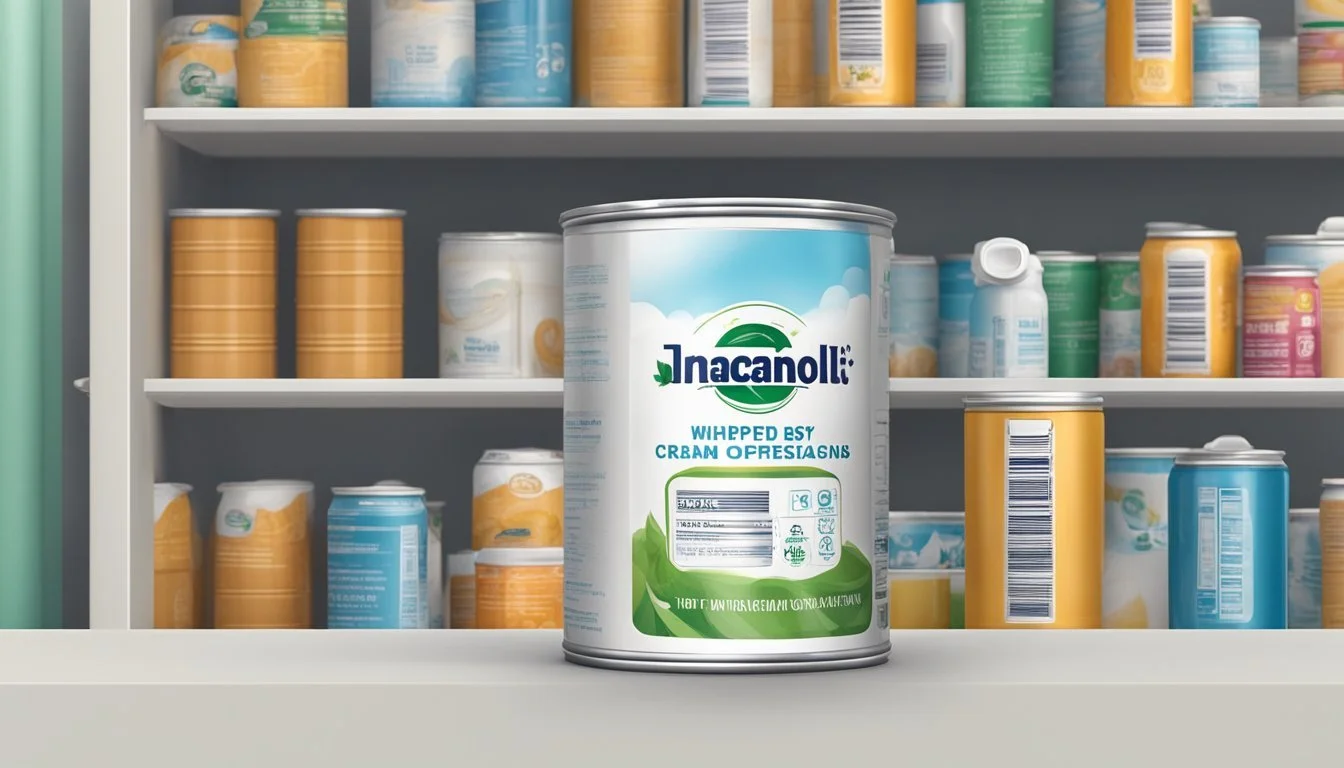Does Canned Whipped Cream Expire?
Understanding Shelf Life and Safety
Canned whipped cream is a staple in many households, adding a delightful finishing touch to numerous desserts. Yes, canned whipped cream does expire. It's important to be mindful of the expiration date printed on the can, as using it past this date can lead to spoilage.
Typically, unopened canned whipped cream can last up to two to three weeks beyond its expiration date. Once opened, it generally stays fresh for about 2-3 weeks if kept refrigerated. Ensuring proper storage in the refrigerator is crucial to maintaining its quality and taste.
Understanding how long canned whipped cream lasts helps prevent food waste and ensures safety. Always check for signs of spoilage, such as changes in texture or smell, before use.
Understanding Whipped Cream
Whipped cream is a popular topping for desserts. It can be made at home or bought in canned form, each with distinct characteristics.
Differences Between Homemade and Canned Whipped Cream
Homemade whipped cream is made by whisking heavy cream, often with added sugar and vanilla extract. It tends to have a richer, fresher taste.
Canned whipped cream, also known as aerosol whipped cream, is pre-packaged in a canister. This type is pressurized with nitrous oxide which helps dispense the cream in a whipped form.
Homemade versions usually have a shorter shelf life, typically lasting up to 4 days. The canned variety, thanks to preservatives and the sealed environment, can last for several weeks past its printed expiration date.
Ingredients and Stabilizers in Canned Whipped Cream
Canned whipped cream typically contains heavy cream, sugar, and flavorings. However, to ensure a longer shelf life and maintain its texture, it also includes various stabilizers.
Stabilizers like gelatin or guar gum help keep the cream from separating. Aerosol whipped creams may also contain nitrous oxide to provide the whipping action.
Some canned whipped creams include non-dairy components, making them an option for those with lactose intolerance. These may contain milk solids or other dairy substitutes to mimic the creamy taste and texture of real whipped cream.
Shelf Life and Expiration
Canned whipped cream, like many dairy products, has a shelf life that can vary based on several factors. Understanding how to read expiration dates and recognize what affects the shelf life of dairy items can help ensure that the product is consumed at its best quality.
Reading Expiration Dates on Canned Whipped Cream
The expiration date is usually printed clearly on the can. It is essential to distinguish between different types of dates: sell by, use by, and expiry date.
Sell by date: Indicates when the retailer should remove the product from shelves. Not necessarily the date by which it must be consumed.
Use by date: The manufacturer's recommended date to consume the product for peak quality.
Expiry date: The last date suggested for the consumption of the product for safety reasons.
After the expiry date, it's crucial not to consume the product as it may be unsafe. Sell by and use by dates can still provide a buffer of usability, provided the product shows no signs of spoilage.
Factors Affecting Shelf Life of Dairy Products
Several factors can influence the maximum shelf life of canned whipped cream. Storage conditions are critical.
Temperature: Keeping it in a cool environment extends its shelf life.
Light exposure: A dark pantry is ideal as light can accelerate spoilage.
Seal integrity: Ensure the can is undamaged and sealed properly. Any compromise could lead to quicker spoilage.
Using these practices can potentially extend the shelf life of canned whipped cream beyond its sell by date and maintain better quality for a more extended period.
Signs of Spoilage in Whipped Cream
When whipped cream spoils, it becomes evident through various visual, textural, and sensory changes. Identifying these signs early prevents the consumption of expired or unsafe products.
Visual and Textural Changes
Color and consistency are primary indicators of spoilage. Fresh whipped cream is typically white and has a light, airy texture. If the whipped cream turns yellowish or develops spots, it should be discarded.
Another sign is separation. Spoiled whipped cream often separates into a watery base and a more solid top layer. This change in consistency indicates that the product has undergone spoilage and is no longer suitable for consumption.
Foamy whipped cream losing its volume and becoming flat is another visual cue that it has expired. Visual and textural changes are reliable indicators, pointing to the need for caution.
Odor and Flavor Alterations
Spoiled whipped cream emits a distinctive sour taste and a funky smell. Fresh whipped cream has a neutral, slightly sweet aroma. When it goes bad, the bacteria present produce lactic acid, causing this unmistakable off odor.
Flavor alterations are also telling. Spoiled whipped cream will taste sour or tangy rather than sweet and creamy. If there’s any hint of bitterness or a sharp taste, it should be discarded immediately.
Regularly checking these sensory features can help in preventing the consumption of spoiled whipped cream. Strong and unpleasant odor or flavor changes are clear indicators that spoilage has occurred.
Safe Usage and Handling
Ensuring the freshness and safety of canned whipped cream requires careful attention to hygiene and preventing cross-contamination. Proper handling practices help maintain optimal quality and minimize health risks.
Hygiene and Clean Utensils
Maintaining cleanliness is critical when handling canned whipped cream. Always start with clean hands. Wash your hands thoroughly before touching the nozzle or any part of the can. It is important to use sterilized utensils if the whipped cream is being transferred to another container.
Sterilized utensils, such as spoons and spatulas, help prevent bacterial growth. Before use, wipe the nozzle clean to remove any residue from previous applications. This simple step ensures the product remains uncontaminated.
Also, avoid letting the nozzle touch other food items or surfaces to minimize the risk of introducing bacteria. Clean storage conditions are vital as well; always store the can in a refrigerator at the recommended temperature.
Avoiding Cross-Contamination
Cross-contamination can jeopardize the freshness and safety of your canned whipped cream. Do not use the same utensils for different foods without washing them in between. This prevents transferring bacteria or other contaminants to the whipped cream.
When serving, avoid spraying directly onto foods that are likely to harbor bacteria, such as raw meats or unwashed fruits. Use caution when applying whipped cream in environments where there are multiple food items present. Designate specific utensils for tasks related to the whipped cream.
Labeling and dating opened cans can help keep track of when the product was first used, ensuring old or spoiled cream is not consumed. Lastly, discard any can that shows signs of spoilage, such as an off odor or unusual taste, to ensure safety.
Utilizing Whipped Cream
Whipped cream has numerous uses in both everyday and gourmet culinary applications. Beyond the usual dessert toppings, it can be creatively applied to various dishes and beverages, enhancing their quality and taste.
Culinary Applications for Whipped Cream
Whipped cream serves as a delightful topping for a wide range of desserts such as pies, cakes, and ice cream. It's a staple in many baking recipes, adding a light and fluffy texture to pastries and tarts. For those who enjoy coffee, freshly whipped cream can provide a luxurious touch to beverages like cappuccinos and hot chocolate. Additionally, whipped cream can be used in savory recipes, offering a creamy contrast when paired with spicy or tangy dishes.
In terms of quality, using freshly whipped cream made from heavy cream yields the best flavor and texture. However, Cool Whip and other whipped toppings also provide convenience and shelf stability. It's crucial to use a clean nozzle to maintain the freshness of canned whipped cream, preventing contamination and preserving its airy consistency.
Creative Ideas for Leftover Whipped Cream
Leftover whipped cream can be creatively repurposed in numerous ways. It can be mixed with a bit of sugar and used as a topping for fresh fruit, turning a simple snack into a delightful treat. Whipped cream can also be incorporated into breakfast dishes, such as on waffles or pancakes, enhancing their presentation and taste.
For a fun and easy dessert, try making a whipped cream parfait with layers of fruit, granola, and whipped topping. Additionally, leftover whipped cream can be frozen in small dollops on a baking sheet and used later as a quick garnish for desserts and hot beverages. This method ensures none of the creamy goodness goes to waste while maintaining its quality and freshness.
Troubleshooting Common Issues
Canned whipped cream can present several challenges that consumers need to manage effectively. This section navigates through the most common issues like separation and consistency to ensure optimal use.
Handling Separation in Whipped Cream
Separation in canned whipped cream is a frequent problem. This typically happens due to temperature fluctuations or improper storage.
If the cream shows signs of separation, shaking the can vigorously for about 15-20 seconds can help reintegrate the components. Always ensure the can is stored at a consistent, cold temperature, ideally under 40°F (4°C). Avoid frequent thawing and freezing, which accelerates separation.
Key steps:
Check Storage: Always maintain a consistent cold temperature.
Shake Well: Shake the can thoroughly before each use.
Avoid Thawing/Freezing Cycles: Minimize temperature changes.
If the cream still seems separated after these steps, it may be nearing the end of its usability.
Reviving Whipped Cream Consistency
In cases where the whipped cream's consistency has weakened, there are ways to restore it. Consistency issues often arise from prolonged storage or exposure to warm temperatures.
Method to revive consistency:
Cooling: Place the can in the coldest part of the refrigerator for about 15-30 minutes.
Shaking: Shake the can forcefully for a few seconds to mix the cream and propellant.
Use Chilled Equipment: If transferring to a bowl, use chilled utensils to keep the cream cold.
If the whipped cream does not return to its proper texture, it is best to replace the can. Ensuring the product is always stored at appropriate temperatures can prevent most consistency problems.
Alternative Approaches to Dairy Products
For those seeking different options to traditional whipped cream, dairy-free and homemade alternatives offer viable solutions. These options cater to diverse dietary needs and preferences, including vegan and lactose-intolerant individuals.
Exploring Non-Dairy Whipped Cream Options
Non-dairy whipped creams are an excellent choice for people who cannot consume dairy. Brands typically use bases like coconut milk, soy, almond, or oat milk. Each variety brings unique flavors and texture differences, with coconut milk providing a rich, tropical taste.
Stores offer various non-dairy whipped creams, some of which are available in cans, similar to traditional dairy whipped cream. Coconut milk, for instance, is a popular base due to its high-fat content, which helps achieve the desired texture. Soy-based whipped creams are another common alternative, appreciated for their relatively neutral flavor.
Tables listing common non-dairy options can offer:
Base Ingredient Characteristics Coconut Milk Rich, creamy flavor Soy Milk Neutral taste, versatile use Almond Milk Slight nutty undertone Oat Milk Mild flavor, creamy texture
Homemade Alternatives to Canned Whipped Cream
Making whipped cream at home allows for customization and control over ingredients. A common homemade dairy version includes heavy whipping cream and vanilla extract, beaten until they form stiff peaks.
For a non-dairy homemade whipped cream, one might use chilled coconut cream, which is the thickened part of coconut milk that separates when refrigerated. This can be whipped similarly to dairy cream. Adding a stabilizer like agar-agar can help maintain texture.
Combining vanilla extract with these alternatives enhances flavor. Freezing these mixtures can extend their shelf life, although they should be thawed properly before use to maintain quality.
Here is a simple recipe for homemade whipped cream:
Dairy Version: Whip 1 cup of heavy whipping cream with 1-2 tablespoons of sugar and 1-2 teaspoons of vanilla extract until stiff peaks form.
Non-Dairy Version: Chill a can of coconut milk, scoop out the cream portion, and whip with sugar and vanilla extract until it reaches the desired consistency.
These methods ensure fresh, customizable whipped toppings suitable for various dietary needs.
Health and Safety Considerations
Proper storage and understanding of the pasteurization process ensure the safety of canned whipped cream. Recognizing food poisoning symptoms is crucial to prevent health risks.
Understanding Pasteurization in Cream
Pasteurization is key in making canned whipped cream safe for consumption. This process involves heating the cream to destroy harmful bacteria without affecting flavor or texture. By eliminating naturally occurring bacteria, pasteurization extends the shelf life and maintains the product's quality.
Unpasteurized cream poses higher risks of containing bacteria like Listeria and Salmonella. These can cause severe health problems. It is vital to ensure your canned whipped cream comes from reputable sources where pasteurization practices are strictly followed.
Recognizing Symptoms of Food Poisoning
Food poisoning from spoiled whipped cream can present various symptoms. Common signs include abdominal cramps, nausea, vomiting, and diarrhea. These symptoms typically appear within hours after consuming contaminated cream but can occur up to several days later.
Immediate medical attention is advised if severe symptoms like high fever, persistent vomiting, or dehydration occur. Understanding these symptoms helps in seeking timely treatment and preventing further consumption of potentially hazardous food products.
Regularly checking the expiration date and proper storage in the refrigerator are essential steps. Never ignore spoilage signs such as an unusual odor, flavor, or texture. These precautions can effectively minimize the risk of food poisoning from canned whipped cream.









